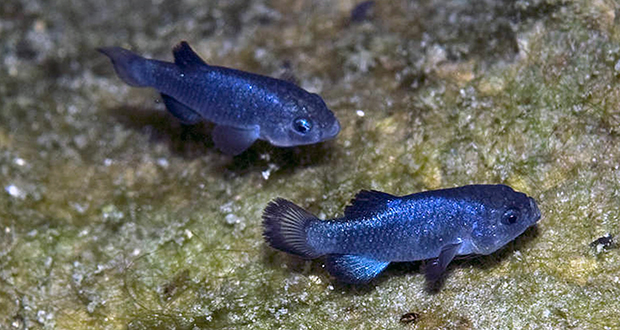1Radiation mushroom

There are species of mushrooms that feed off of gamma radiation, and some are blooming in Chernobyl, “eating” the radiation.
2. Among starfish that can regenerate their entire body from a single-arm, some can do so from just 1cm (0.4 inches) long. In fact, in some species of starfish, a large female can split in half; each half becoming a male which then transforms back into a female once it grows big enough.
3. A small hopping insect named the Issus Coleoptratus uses toothed gears on its joints to precisely synchronize the kicks of its hind legs as it jumps forward. This insect has the only mechanical gears ever found in nature.
4. Out of 46,000 discovered species of spiders, only a single one (Bagheera kiplingi) has been found to be a herbivore.
5. An explorer once found a compound named calanolide A, in certain trees in Malaysian rainforest. Researchers then found out that it had anti-HIV properties. Unfortunately for them they couldn’t find another sample for nine years as almost all the trees of that species had been cut down for firewood and building material.
Latest FactRepublic Video:
15 Most Controversial & Costly Blunders in History
6Gros Michel

Banana candy doesn't taste like banana because the flavoring was invented while an old species of banana was popular, the Gros Michel, which tastes different from the currently popular banana, the Cavendish. Panama disease wiped out the Gros Michel but the artificial flavor never changed.
7. An ultra-rare species of blue bees (blue calamintha bee) has recently been rediscovered after missing for 4 years. They are hyper-local species and only live around an isolated patch of sand dunes along the central Florida ridge. Before 2020, they were last seen in 2016.
8. There is a species of butterfly that feeds only on specific plant (Artemisia Vulgaris), which happens to like soil above mass graves. Forensic teams followed these blue butterflies to help them uncover the mass grave sites in Rwanda.
9. A fig tree tricks a certain species of wasp to pollinate it, sends it down a small passage in the fruit where its wings are ripped off, after which it is digested by enzymes. Figs eat wasps.
10. Pestalotiopsis microspora is a species of fungus from the Amazon that feeds on plastic. It can live on plastic alone and can do so without oxygen, potentially leading to new techniques for bioremediation.
11Devils Hole Pupfish

The Devils Hole Pupfish is species that exists within a 22 by 3.5 meter pool in Death Valley. In 2007, as few as 38 individuals remained. As of spring 2019, the population had reached 136.
12. Malabar giant squirrel is a squirrel species that’s endemic to India. They have multicoloured fur and can get up to 3 feet in length.
13. The Ginkgo Biloba species of tree is 270 million years old. It rarely suffers from disease or insect attack and was one of the only living things to survive the Hiroshima nuclear bombing. The trees healed quickly and are still alive today.
14. A rare species of tree snail discovered in Australia in 2009 was named Crikey Steveirwini. The discovering scientist noted its khaki appearance and decided the only appropriate name was one that would honor the late Crocodile Hunter and his signature catchphrase.
15. Out of thousands of Frog species, only one goes “RIBBIT”, but it has become a global cliche of how a frog sounds because that particular frog specie (Pseudacris regilla) resides on the West Coast of the USA, where Hollywood is, and were recorded for sound effects in classic Hollywood movies.
16Bacteria species

In 2012, scientists found 1,458 new species of bacteria living in human bellybuttons. Everyone’s bellybutton ecology is unique like a fingerprint, and one volunteer’s belly button harbored bacteria that had previously been found only in soil from Japan, where he had never been.
17. There is a species of butterfly named the Julia Butterfly that licks the eyes of caimans and turtles so that it can drink their tears.
18. A study showed that plants have the potential to store memory. Mimosa pudica is plant species that closes up it leaves when touched. In an experiment it was repeatedly dropped. At first, it closed on every drop but over time remained open because the drops did not harm them. It retained this memory even a month later.
19. There is a species of scorpion (Ananteris balzani) that loses its tail when threatened, just like a lizard. Trouble is, its anus is located at the end of its tail, meaning it may survive for up to eight months sans anus, and without ever defecating again.
20. Dayak fruit bat is a species of bat in which males naturally produce milk.
21Kea

Kea is a species of predatory parrot that is found in New Zealand. It is infamous for killing sheeps using their beaks and damaging parked vehicles.
22. Neotrogla is fly-like insects native to Brazil. They are the first species that are known to have swapped genital structures. Copulation lasts 40-70 hours during which the female uses spines on her gynosome (penis) to latch onto the male and if forced apart, his abdomen can be ripped apart from his body.
23. The Suriname toad species gives birth from their back by having eggs embedded into their skin.
24. Seahorses are among the only species in which the male gives birth and takes care of the young.
25. The Sun Bear is the world’s smallest bear species that grows to only 28 inches tall. Sun bears are shy and reclusive and may bark if startled. They prefer to spend their time away from people (and predators), sunbathing and sleeping in trees.




